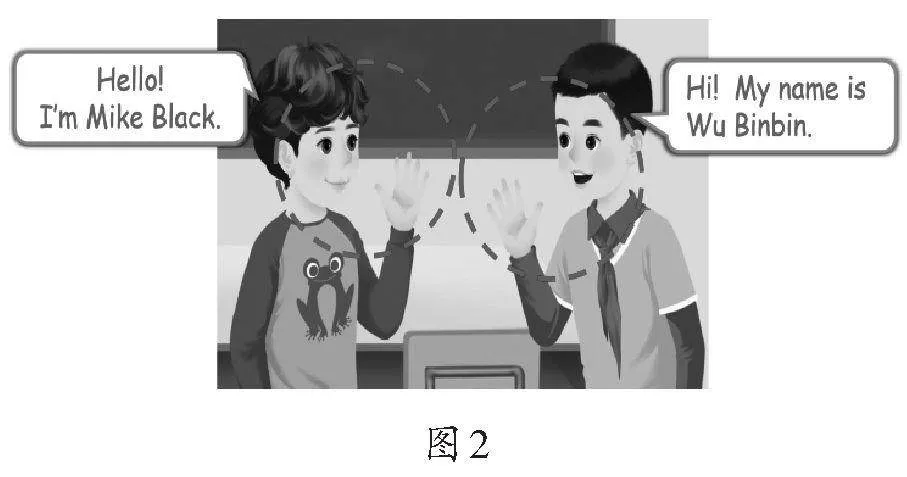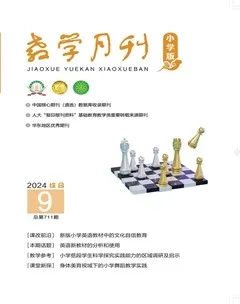英语新教材“对话教学”实践





一、教材分析
本课教学内容选自《义务教育教科书 英语(PEP)》三年级上册Unit 1 Making friends。本单元以“How do we make friends?”为线索,围绕Part A中的子问题“How do we greet friends?”和Part B中的子问题“How can we be a good friend?”展开。本课是一节对话课,是本单元的第1课时,教学内容主要是Mike和Wu Binbin互相认识时的对话。
二、教学目标
能够通过听录音、看图、观看配套动画等方式认识Mike和Wu Binbin;能够理解对话大意,知道用英语与人打招呼的不同方式。
能够听懂基本的问候语,能用“Hello!” “Nice to meet you.”打招呼并作出回应。
了解中、英文姓名的不同表达方式,能用“My name is .../I am ...”等句型介绍自己的姓名。
能够听懂歌曲大意,识别歌曲中的基本问候语,并能根据曲调吟唱歌曲。
能够对照配套录音跟读对话,有模仿录音中的语音、语调的意识,注意“Nice to meet you.”句型中“meet”与“you”的连读。
三、教学重难点分析
重点:能用“Hello!”“Nice to meet you.”打招呼并作出回应;能用“My name is .../I am ...”介绍自己的姓名。
难点:正确朗读教材中人物的名字,如 “Mike Black”“Sarah Miller”等;理解“Sing and role-play”中的歌曲大意,识别歌曲中的基本问候语,并能根据曲调吟唱歌曲。
四、教学过程
(一)热身与复习
1. Let’s sing
课件播放动画视频Nice to meet you,引导学生欣赏,而后尝试跟着视频吟唱,并尝试在吟唱过程中加入动作,如挥手、握手等。
2. Look and say
T: Boys and girls, look at the children, they are ...(课件出示该动画中的人物)
Ss: Friends.
T: Yes, and two of them are talking.
接着,课件出示两组图片(如图1),一组图片中Mike Black与Wu Binbin在打招呼,另一组图片中Mike Black与John Baker在打招呼。学生通过图片认识教材人物。
(二)呈现与操练
1. Listen and tick
T: Who are talking? Let’s listen and tick the right picture.(播放对话音频,引导学生勾选相应的图片)
2. Watch and check
T: Now let’s watch the video and check.(播放Let’s talk部分的动画视频)
T: Who are talking?(板贴出示人物对话图)
Ss: Mike Black and Wu Binbin.
T: Yes, and they say ... (播放人物自我介绍的对话音频,引导学生关注句型“Hello! I’m ...”“Hi! My name is ...”)
T: Look at them, they wave their hands, they smile, they are greeting! How do we greet friends?(引入如图2所示的人物对话图)
3. Watch again and find out
T: Now let’s watch again and find out.(再次播放教材Let’s talk部分的动画视频,引导学生关注人物打招呼时所用的语言及肢体动作)
T: So what do they say to greet friends?
Ss: Hello! I’m Mike Black. Hi! My name is Wu Binbin. Nice to meet you. Nice to meet you too.(板贴出示句型“Hello! I’m ...”“Hi! My name is ...”“Nice to meet you.”“Nice to meet you too.”)
T: Good job. Read after me. Hello! I’m Mike Black. (教学目标语言,引导学生关注“I’m”“name”等发音,关注“meet you”的连读发音)
T: Good, now we can watch the video again and feel it.(引导学生再次观看Let’s talk部分的动画视频,感受人物打招呼时的眼神、表情、肢体动作等)
4. Listen and imitate
教师播放音频,引导学生大声跟读、模仿语音语调。
5. Role-play
T: Please act correctly, fluently and vividly. And don’t forget the body language. Then you can get all the stars.(引导学生两两合作进行角色扮演并关注表1所示的评价标准)
T: For example, I want to be Mike Black, who can be Wu Binbin?(与学生配合表演)
T: Boys and girls, are we good?(结束后引导其他学生给予评价)
Ss: Yes!
T: Thank you. I think we are good too. Because when we are greeting, we “look into the eyes”, we “smile” and we “wave our hands”. They are good ways to greet friends. Now it’s your turn to role-play with your partners, have a try!(板贴出示相应图标,如“微笑”“挥手”等)
(三)巩固与拓展
1. Listen and number
T: The children are making friends with each other. But who are they? (课件出示如图3所示的教材人物,引导学生认识新人物)
T: Now let’s listen and number.(引导学生听录音,给人物排序,录音内容如下)
Hi! My name is Wu Binbin.
Hello! My name is John Baker.
Hello! My name is Chen Jie.
Hello! I’m Mike Black.
Hi! I’m Sarah Miller.
2. Choose and role-play
T: We know their names. They are ... (板贴出示教材人物图,引导学生依次说出人物名字)
Ss: Mike Black, Sarah Miller, John Baker, Wu Binbin and Chen Jie.
T: Yes, and we can do more role-plays.(引导学生选择并扮演教材人物,两两合作完成对话表演)
T: Hello, my name is Sarah Miller.
S: Hi, I’m Chen Jie.
T: Nice to meet you.
S: Nice to meet you too.
T: Let’s shake hands, OK?
S: OK!
在师生示范表演的过程中,教师可以渗透更多有关“打招呼”的语言及肢体动作,引导学生丰富表演内容。
T: Now it’s your turn to choose and role-play with your partners, have a try!
3. Listen and circle
T: Some children are singing. Who is singing? Let’s listen and circle.(播放Listen, sing and role-play部分的歌曲音频,引导学生圈出相应人物)
T: Who is singing?
Ss: Sarah Miller and John Baker.
4. Watch and find out
T: Yes, and the song is about greeting.How do they greet friends? Now let’s watch and find out.(播放Listen, sing and role play部分的动画视频,引导学生关注人物打招呼时的语言、表情及肢体动作等)
T: What do they say to greet friends?
S1: Hello there!
S2: Let’s be friends.
S3: My name is ...
S4: Let’s shake hands.
T: Good! Shaking hands is also a good way to greet friends and there are more ways.(板贴出示“握手”图标,引导学生关注更多有关“打招呼”的语言及肢体表达)
5. Sing and role-play
T: Let’s watch again, then sing and role-play with your partners. Have a try! (再次播放Listen, sing and role play部分的动画视频,引导学生两两合作,跟着动画视频,唱一唱,演一演)
6. Choose, sing and role-play
T: Good job! We can choose more roles and make a new song! Please choose, sing and role-play with your partners.(引导学生选择并扮演教材人物,两两合作创编歌曲,唱一唱,演一演)
T: Hello there! Let’s be friends. My name is Mike. Let’s shake hands.(向学生示范)
S: Nice to meet you. I am Sarah. Hello! Hello! Hello! Hello!
T: Let’s play, OK?
S: OK.
7. Make a new dialogue
T: Boys and girls, now you know your partners’ Chinese names. But can you talk with your friends about your English names or nicknames?(引导学生两两合作,创编对话,介绍自己的英文名或其他昵称,增进彼此之间的了解)
T: Hello! My name is Spencer.(向学生示范)
S: Hi! I’m Neinei.
T: What a cute name! Nice to meet you, Neinei.
S: Nice to meet you too!
板书设计如图4所示。
(四)家庭作业
听录音,熟练朗读并进行对话。
完成《英语作业本》的相应题目。
结合实际,改编本课对话。
五、教学反思
(一)立足文本语境,感知主题意义
本课的教学内容为小学英语学习的起始内容,主要围绕“如何与朋友打招呼”展开,目标语言有“Hello!/Hi!”“My name is .../ I’m ...”“Nice to meet you.” “Nice to meet you too.”等。作为初学者,学生的语言感知能力较弱,语言知识储备较少,因此教师需要立足文本语境,通过听音、观看动画视频等活动,多次滚动复习语篇内容。这样能够降低学习难度,吸引学生的注意力,提高学生的学习兴趣,帮助学生感知与理解语篇大意,为后续推进活动做好铺垫。
(二)深挖教材语篇,提炼主题意义
在授课过程中,教师不仅充分运用教材音频和视频等数字资源呈现新知,还设计了相应的教学活动,由浅入深地挖掘教材语篇,逐步突破教学难点。针对Let’s talk板块,教师先播放对话音频,引导学生获取人物信息,然后播放动画视频,让学生感知对话情境,渗透目标语言。在此过程中,教师引导学生读图,关注人物的语言、表情及肢体动作,感知“Greeting”这一主题。接着,教师再次播放动画视频,引导学生深入理解“How do we greet friends?”这一主题,感知整体语境,感受人物交朋友、打招呼时需要“看着对方的眼睛”,可以用“微笑”“挥手”等方式表达情感。
(三)拓展语境运用,内化主题意义
教师设计了多种活动,如“Listen and number”“Listen and circle”“Choose, sing and role-play”等,不断拓展语境运用,让学生初步学习运用语言,使抽象的语言知识形象化、具体化。通过视听结合的方式,学生不断输入目标语言,增强对目标语言的理解,进一步感知“How do we greet friends?”这一主题意义。在滚动复现中,学生习得了语言,学习目标有效达成。

